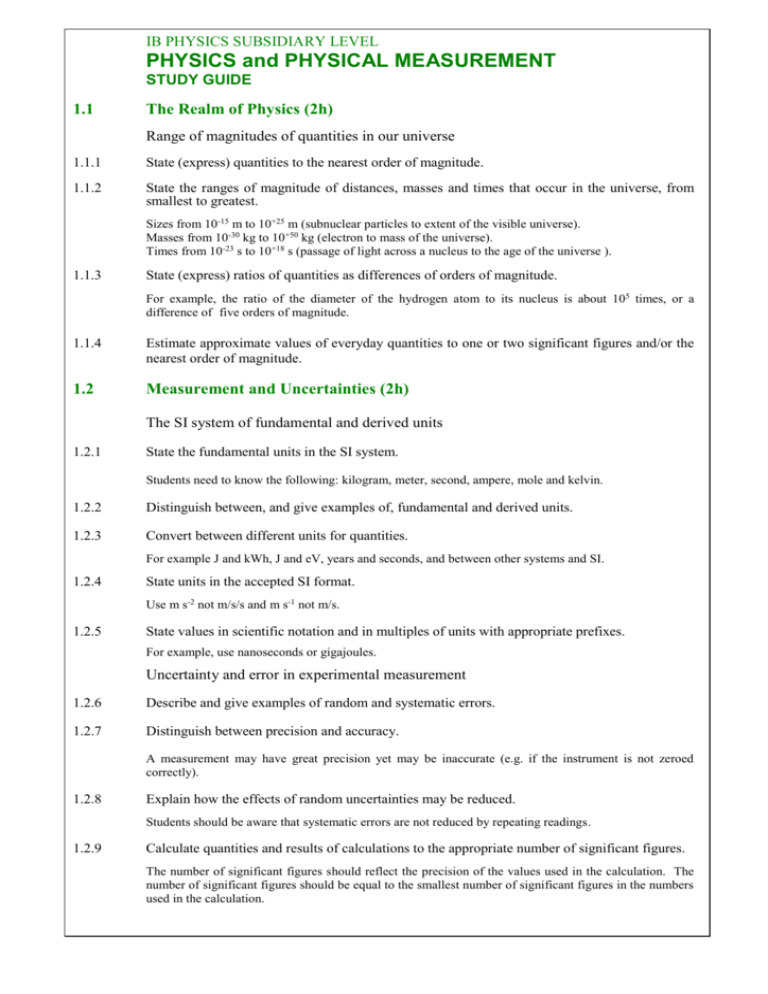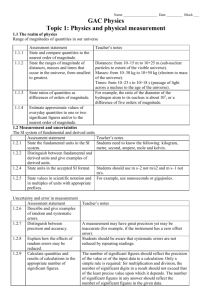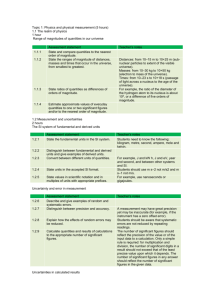IVANHOE GRAMMAR SCHOOL
advertisement

IB PHYSICS SUBSIDIARY LEVEL PHYSICS and PHYSICAL MEASUREMENT STUDY GUIDE 1.1 The Realm of Physics (2h) Range of magnitudes of quantities in our universe 1.1.1 State (express) quantities to the nearest order of magnitude. 1.1.2 State the ranges of magnitude of distances, masses and times that occur in the universe, from smallest to greatest. Sizes from 10-15 m to 10+25 m (subnuclear particles to extent of the visible universe). Masses from 10-30 kg to 10+50 kg (electron to mass of the universe). Times from 10-23 s to 10+18 s (passage of light across a nucleus to the age of the universe ). 1.1.3 State (express) ratios of quantities as differences of orders of magnitude. For example, the ratio of the diameter of the hydrogen atom to its nucleus is about 105 times, or a difference of five orders of magnitude. 1.1.4 Estimate approximate values of everyday quantities to one or two significant figures and/or the nearest order of magnitude. 1.2 Measurement and Uncertainties (2h) The SI system of fundamental and derived units 1.2.1 State the fundamental units in the SI system. Students need to know the following: kilogram, meter, second, ampere, mole and kelvin. 1.2.2 Distinguish between, and give examples of, fundamental and derived units. 1.2.3 Convert between different units for quantities. For example J and kWh, J and eV, years and seconds, and between other systems and SI. 1.2.4 State units in the accepted SI format. Use m s-2 not m/s/s and m s-1 not m/s. 1.2.5 State values in scientific notation and in multiples of units with appropriate prefixes. For example, use nanoseconds or gigajoules. Uncertainty and error in experimental measurement 1.2.6 Describe and give examples of random and systematic errors. 1.2.7 Distinguish between precision and accuracy. A measurement may have great precision yet may be inaccurate (e.g. if the instrument is not zeroed correctly). 1.2.8 Explain how the effects of random uncertainties may be reduced. Students should be aware that systematic errors are not reduced by repeating readings. 1.2.9 Calculate quantities and results of calculations to the appropriate number of significant figures. The number of significant figures should reflect the precision of the values used in the calculation. The number of significant figures should be equal to the smallest number of significant figures in the numbers used in the calculation. 2. 1.2.10 State uncertainties as absolute, fractional and percentage uncertainties. 1.2.11 Determine the uncertainties in results. When adding and subtracting, add the uncertainties. For multiplication, division and raising to powers, add fractional or percentage uncertainties. For other functions, determine maximum and minimum values, calculate the mean and determine the uncertainty. Uncertainties in Graphs 1.2.12 Show uncertainties as error bars in graphs. 1.2.13 State random uncertainty as an uncertainty range () and represent it graphically as an error bar. Error bars are only needed when the uncertainty in one or both of the plotted quantities is significant. Error bars will not be expected for trigonometric or logarithmic functions. 1.2.14 Determine the uncertainties in the gradient and intercepts of a straight line graph. 2.1 Kinematics (6h) 2.1.1 Define displacement, velocity, speed and acceleration. Quantities should be identified as scalar or vector quantities. 2.1.2 Explain the difference between instantaneous and average values of speed, velocity and acceleration. 2.1.3 Draw and analyse distance-time graphs, displacement-time graphs, velocity-time graphs and acceleration-time graphs. Students should be able to sketch and label these graphs for various situations. They should also be able to write descriptions of the motions represented by such graphs. 2.1.4 Calculate and interpret the gradients of displacement-time graphs and velocity- time graphs and the areas under velocity-time graphs and acceleration-time graphs. 2.1.5 Describe the effects of air resistance on falling objects. No calculations are required, descriptions only. Students should understand what terminal velocity means. 2.1.6 Identify the acceleration of a body falling in a vacuum near the Earth’s surface with the acceleration of free fall g. 2.1.7 Outline the conditions under which the equations of uniform acceleration may be applied. 2.1.8 Solve problems involving the equations of uniformly accelerated motion.








